Table of contents
- Bonn and the surrounding area Bonn plus ultra
- Impressive: Bonn museums
- Info – Bonn and the surrounding area
- The motorcycle – Bonn and its surroundings
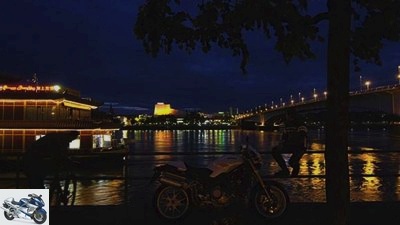
Daams
to travel
Bonn and the surrounding area
Bonn and the surrounding area
Bonn plus ultra
Federal capital ?? that is a thing of the past for Bonn. But the lights on the Rhine have not gone out. On the contrary, a trip to the capital a. D. brings radiance to light: tradition and change, culture at a high level and a lot of quality of life.
Thomas Schmieder
10/17/2006
No need for haste. Kathleen and I stop and get off the Ducati Monster S4Rs. Jupp takes his bearings, takes measurements. He hurls metal at metal in a high arc. Clone. Well made. With the first throw, “for laying on the pig,” the heavy balls are better, says Jupp. What the tires mean to the motorcyclist, his balls mean to the boules player. Teammate Werner introduces us to the metaphysics of the game: »The concentration is incredibly high. The only thing left is the sphere, like when you drive a motorcycle, you ignore everything else. ”He should know because, we learn, he owns two Guzzis, an 850 T3 and a Mille GT. It is not difficult to get into conversation with people from the Rhineland. Especially on this Duc with its mother-of-pearl paint and fire-red tubular space frame.
It is parked in one of the most stylish squares in Bonn, at the end of Poppelsdorfer Allee. Two double rows of chestnut trees connect two baroque castles as a splendid axis. Until the end of the 18th century, Bonn was the residence of the Cologne electors. The university has been located in both palaces since 1818, with over 30,000 students one of the largest in Germany. The historic houses along the one kilometer long Poppelsdorfer Allee, together with the south and west towns on both sides, form the largest Wilhelminian style district in Germany. Every facade is different and is composed of stucco, bay windows and balconies, yellow, red or black bricks and contrasting white window frames. Ornate entrance doors or turrets on the roofs represent wealth as it was now. City planning for the heart.
Buy complete article

Bonn and the surrounding area
Bonn plus ultra
12 pages) as PDF
€ 2.00
Buy now

Daams
The street cafes offer box seats in front of the Rococo town hall.
Kathleen can’t believe it. “I always imagined Bonn to be very cruel. I only knew the city from the Tagesschau. «She came from Thuringia. And now with their prejudices at the end: “Well, Bonn, for us they were always old men in front of ugly gray houses.” Only a stone, pardon, ball throw away, the Poppelsdorf Palace rests in itself: sublime, dignified and elegant . Behind it is one of the most beautiful and oldest botanical gardens in the whole country. Ennobled by the Guinness Book of Records: The titan arum, which bloomed here in the tropical house at the end of May 2003, is the largest flower in the world at 2.74 meters high. Outside, in the sun, oleanders and other Mediterranean plants stand firmly rooted, graceful wall lizards scurry around. Loud croaks fill the air. A troop of ring-necked parakeets flies past, rapidly and with tearing wings. 300 couples live wildly in Bonn. Everyone benefits from the city’s mild climate. That can also be oppressively humid in summer, shaped by the location in the valley basin with the huge heat storage Rhine. The winters are said to be the warmest in all of Germany. Is that why the people of Bonn speak of the “northernmost city in Italy”? Or do you mean the Mediterranean-casual way of life, in a city full of street cafes and beer gardens? In the sixties it was said that Bonn was half the size of Chicago’s central cemetery. But twice as dead. The name alone would come from “Federal capital without any nightlife worth mentioning”. Can there be something to it. Because if you are looking for an open restaurant here after 11 p.m., it will be difficult, despite all the takeaways.
Bonn is not Cologne, never developed into a cosmopolitan city and has “only” 315,000 inhabitants. With an increasing tendency, completely contrary to trend in Germany. Paragraph 1 of the Rhenish Basic Law, which is based on »Bonnsch«, comes into play: »Et es wie ?? t es.« Rhinelander take life with a sense of humor. Just like the 61-year-old, extremely fun-loving retailer Johannes Vollmar, whom we meet on his burgundy-red 1100 Pan European at Kaiserplatz. “Here we solve everything in a liberal Rhenish way,” he says. Every Jeck is different, as the carnival-mad Rhinelander know, live and let live is the top priority.
Only once, in June 1991, when the people of Bonn completely lost their laughter. When the Bundestag decided in a tight decision to move parliament and government to Berlin. What had they fought against on the Rhine, but in vain. Fear of the future was around. Until paragraphs 2, 3 and 4 took effect: “Et kutt, wie et kutt” (it comes as it comes), “et still has jot jejange” (it still went well) and “wat fott es, es fott «(fort is fort): In 1999 the trek of big politics moved from the Rhine to the Spree. We stay, start the city tour with the Duc. Six federal ministries continue to have their first office in Bonn, others a branch office. Together they employ around 10,000 people, more than the Berliners. 22 federal authorities and a number of companies came to the Rhine. Change is a tradition here. Paragraph 5: “Et bliev nix, like et wor” (nothing remains as it is).
For example, the Federal Audit Office is located at the intersection of Weberstrasse and the corner of Adenauerallee. Built in the 1950s as the Ministry of Post, the building later became part of the Foreign Office. Five animal sculptures on the back still tell of it, standing for the five continents: eagle (America), bull (Europe), lion (Africa), elephant (Asia) and kangaroo (Australia, logically). Even without a federal mandate, they are still enthroned over the river, looking into the Siebengebirge. And on the most traveled waterway in Europe in front of the picturesque silhouette of the mountains. In the middle of Bonn, the Rhine curves energetically, is anything but straight or canalized. It attracts people magnetically, as a coast in the middle of the city. Pedestrians, skaters and cyclists in particular benefit from the many kilometers of promenade, as there are only a few streets that accompany the river. On the other side, on the bank in Beuel, children throw pebbles into the water.
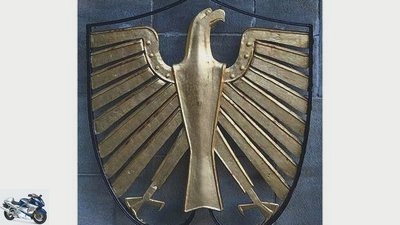
Daams
The government and parliament have left, but in the “Federal city” politics remains present.
We pull ourselves off, start the V2 again. It rolls smoothly, the traffic on the B 9, once the so-called diplomatic racetrack. As the most important north-south axis, it connects Bonn city center with the (former) government district and the southern district of Bad Godesberg, formerly the location of most of the international representations. Embassy cars are still driving around, recognizable by their number starting with a zero, but today they are registered in Berlin. Also noticeable are the many Audis, BMWs and Mercedes with the license plate “BN-DT …”, apparently the Deutsche Telekom vehicle fleet. Which resides here together with its subsidiaries. Today the city has 10,000 more jobs than in 1991. Boomtown Bonn. And Candy City. A sweet smell wafts under the visor? he comes from Haribo in the Kessenich district. Where wine gum is being cooked. In 1920, the candy maker Hans Riegel founded his company in Bonn, with a sack of sugar as start-up capital. Two years later he invented the “dancing bear” made of fruit gum, which became world famous as the Haribo gold bear. Just like the liquorice snail invented here.
We can also discover history at the kiosk at “Langen Eugen”. In the shadow of the parliament building built in 1969, Klaus Dolff has been running his mix of snack bar and drinking hall for 25 years. He experienced a lot there. And to tell: “Friedrich Nowottny came here to eat ice cream every lunchtime,” says Dolff, “in wind and weather, you could set the clock.” Did Nowottny get the strength from this to present the program “Report from Bonn” a thousand times? Helmut Kohl’s pod is also unforgettable. When he had instructed his chauffeur in 1982 to present Chancellor Schmidt, who had just been replaced, with a bouquet of flowers that looked like a giant head of cabbage. “But Mr. Schmidt,” adds the Ducati driver Dolff, “then had his driver bring five live rabbits to the newly vacated Chancellery two weeks later.” As a cabbage killer. “It was a nice, cozy time,
everyone knew everyone else. «Bundesdorf Bonn? Bonn is called the federal city today, only the “main” in the middle has been deleted. The cosmopolitanism, however, remained. For example, twelve United Nations institutions and the UN campus, which is currently being built in the former government district, stand for this; an international congress center is to be the largest in Germany with 6,000 seats. Allegedly they want to move the UN plenum from New York here. World capital Bonn? We rumble past the »Post Tower«, the headquarters of the yellow giant and the tallest office building in North Rhine-Westphalia. First rejected by the Bonners, recognized today. The 162.5 meter high tower is also the seat of the 633 member strong nationwide motorcycle club “Postbiker e.V.”. Along the “Rheinaue” landscape park, we shimmy our way with the Ducati to the city motorway. It’s a shame that today is not the third Saturday of the month
and the largest and most beautiful flea market is boiling far and wide in the Rheinaue.
The A 562, which is just three kilometers long, is the shortest motorway in Germany. But it is of great importance as a south bridge (correct: Konrad-Adenauer-Brucke), because the next one comes only in Koblenz. Otherwise, like on many banks of Bonn, the motto is “Ferryman, get over”. We follow the asphalt on the “Schal sick”, like the one on the left bank of the Rhine
Bonners scoff at the allegedly wrong side of the Rhine. There, in the Siebengebirge, serpentines carry us up to the Petersberg. The former guest house of the federal government is now a noble hotel and restaurant with a great view: All of Bonn is at your feet, and the famous Drachenfels is emblazoned on the left. Beyond that, in Bad Honnef-Rhondorf, a Cologne mayor, deposed by the Nazis, moved into his residence on the steep slope in 1935: Konrad Adenauer. Was that why he had a decisive influence on the choice of capital in 1948/49? The other competing cities had no lobby (Stuttgart), were too badly damaged (Kassel) or did not seem provisional enough (Frankfurt) ?? after all, it was to go back to Berlin later. That was the chance for the city to become a big one. At least mentally.
In Rhondorf we roll over a small bridge to the island of Grafenwerth to the beer garden on the beach. Rhenish Riviera. The eel shocker Aranka anchors in the evening light. It is the last surviving fishing boat of its kind and a reminder of thousands of Rhenish families who still
lived from fishing in the 1920s. But water pollution and expansion measures deprived them of their livelihood. Today the Rhine is once again considered the cleanest river in Europe, and its neighbors have learned from environmental sins. You can swim in it, eat the fish without hesitation and admire the masses of mussel shells on the beach.
Our gaze is fixed on the cargo ships, wandering across the one opposite-
lying »sister island« Nonnenwerth ?? formerly a monastery, now a boarding school ?? to the legendary Rolandsbogen, a scene of the Nibelungen saga. Cozy Bonn has a huge advantage over the big Cologne: the mountains. The Godesburg is the last hilltop castle along the Rhine, here the middle goes into the Lower Rhine.
The next morning calls to the “Bonn Republic” for breakfast. Landlord Guntram Fischer has enriched his restaurant with insignia from the good old days: portraits of politicians, letters to the “Chancellor”, historical photos of state receptions with motorcycle escorts, elections-
posters, Federal Merit Crosses. And an original menu. There is, for example, »Erich Honecker«: a glass of tap water and a slice of dry bread for 38 cents. Or »Joschka Fischer«: muesli with yoghurt and fruit, with a glass of fresh orange juice. Makes 4.90 euros.
Reinvigorated, head to the Konig Zoological Museum, an imposing building made of brown sandstone. Its atrium shows deceptively real worlds from the African savannah. In 1948 it was practically the delivery room of German democracy, when the Parliamentary Council was ceremoniously opened to work out the Basic Law. Presumably, some of the stuffed animals had to move to the side at short notice. Even Adenauer worked here before his office was completely renovated.
On the other side of the street, the snow-white buildings of Villa Hammerschmidt and Palais Schaumburg, ex-residences of the Federal President and Chancellor, shine. We ignore them, just like the considerable houses on the Museum Mile ?? want to go on, over the bends in the Ahr valley to the »Ring«: only 50 kilometers to the Nordschleife! But first we follow the B 9 straight to the south. Where not only the city but also North Rhine-Westphalia ends.
The very first place in Rhineland-Palatinate is impressive: the Peace Museum in the remains of the Remagen Bridge. It became world-famous as the only connection across the Rhine that the Allies could conquer. The demolition by the Germans failed. On March 7, 1945, a vanguard of the 9th US Armored Division hit ?? who supposedly just got lost? to the intact transition: the “miracle of Remagen”. General Eisenhower is said to have proclaimed that the bridge was worth its weight in gold. He sent his troops over it day and night; the German army command tried desperately to destroy the bridge by bombing and fighting swimmers. Hitler had five officers sentenced to death. On March 17, 1945, the badly damaged bridge finally collapsed, killing 28 American soldiers. Today, German and American flags are waving on the pillars high above the Rhine. Sometimes it’s good when times change. Perhaps the people in the Rhineland know that more than anywhere else.
Impressive: Bonn museums
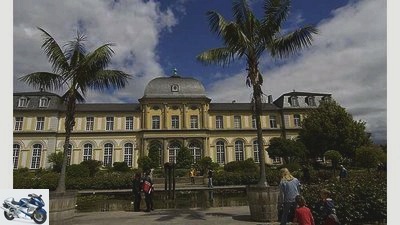
Daams
Poppelsdorf Castle in the Botanical Garden.
The museum landscape in Bonn is astonishingly colorful: contemporary history, art, nature and technology. Art-
and exhibition hall (Bundeskunsthalle) as well as the House of the History of the Federal Republic of Germany form with the
in between the city art museum Bonn the Ruck-
on the beautiful Museum Mile in Bonn.
This also includes the Alexander Koenig Zoological Museum (www.museum-koenig.de), the Bonn branch of the Deutsches Museum and the ifa gallery. Until January 7, 2007, the Guggenheim exhibition in the Bundeskunsthalle (www.kah-bonn.de) is an absolute must for art lovers. Unfortunately, it does not show any bikes from the legendary motorcycle exhibition “The art of the motorcycle”.
Like the Bundeskunsthalle, the House of History (www.hdg.de) has more than 500,000 visitors per year, and entry is free. Many tens of thousands of exhibits bring post-war history to life in both East and West. It also includes vehicles, such as Adenauer’s service Mercedes from the 1950s, a Vespa “Queen” from the same decade or a Zundapp Combinette from 1964 ?? Guest gift for the one millionth guest worker in Germany.
The great exhibition only runs until October 22, 2006
History of rock music, then she moves to the Kronprinzenpalais in Berlin. In addition to video clips, audio samples and record covers, motorcycles and their drivers are also taken into account? “Half-
strong «and rock ?? n ?? Roll once belonged together inseparably.
The “Path of Democracy” makes stations of politics in Bonn accessible ?? on foot or at www.wegderdemokratie.de
on the computer. In 1989 Bonn celebrated its 2000th birthday, the
first Roman camp dates from the year 12 BC. Rich find-
The Rheinisches Landesmuseum (www.rlmb.lvr.de) shows pieces from this era.
And until November 19, 2006 »Roots ?? Roots of Humanity «: Finds of the Neanderthals and various early humans. Ur-Rhinelander colonized the Bonn area as early as 14,000 years ago, which is a testament to that
uncovered double grave and the “dog from Oberkassel”, the oldest evidence of the dog as a pet.
Info – Bonn and the surrounding area
The location of a Roman legion, an important place for the romanticism of the Rhine and the seat of a large university: Bonn attracts with history (s) And with great motorcycle routes on the doorstep.
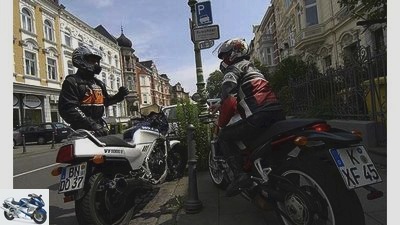
Daams
Bonn encounter: Italians and Japanese in conversation.
getting there
Coming from the southwest, take the A 61 and then the A 565; the »Poppelsdorf« exit leads along the southern part of the city, which is well worth seeing
directly to the museum mile. This is on the B 9, the former “diplomatic racetrack”. Coming from Cologne, the 19-kilometer A 555 leads straight into the city center. It is considered to be the oldest German motorway. On the right bank of the Rhine, the A 59 (airport motorway) leads to Bonn-Beuel. From the southeast, choose the A3 and then the »Siebengebirge« exit. A beautiful route winds its way down into the Rhine Valley near Konigswinter. If you have time, you can travel straight through the picturesque Rhine Valley, on the B 9 or B 42.
gastronomy
The »Bonner Republik«, Adenauerallee 70, phone 0228/2804970, www.bonner Republik.com combines a charming ambience and nice cuisine. The »Bonnsch« brewery serves hearty Rhenish dishes with home-brewed beer in the city center, Sterntorbrucke 4, phone 0228/650610, www.boennsch.de. The same applies to the “Machold” beer house in the old town, Bonn’s liveliest pub district, Heerstrabe 52, phone 0228/9637877, www.bierhaus-machold.com, and the “Zum Roten Lowen” brewery in the cute neighboring town of Siegburg, Holzgasse 37 ?? 39 , 53721 Siegburg, phone 02241/55999, www.siegburger-brauhaus.de. Take a look at the »Zone« in Bonn’s old town, the landlord drives a Triumph Tiger. Pure Rhine romance: Rolandseck train station, located directly south of Bonn on the B 9. In the classicist jewel from 1856 you sit above the Arp Museum in a sublime ambience (photo on the right). The large terrace with cast-
iron balconies offer a great view, the artistically designed toilets drastic erotic representations; Telephone 02228/911111, www.interieur-no253.de. Further south, in Sinzig, home of the BMW tuner Wunderlich, the »Vieux Sinzig« serves French cuisine for gourmets. Kolner Strasse 6, 53489 Sinzig, phone 02642/42757,
www.vieux-sinzig.com. The Haribo factory outlet in Friesdorfer Strabe 121, 53175 Bonn, phone 0228/9092930, www.haribo.de offers a different culinary spectrum. A price war is currently raging in Bonn among oriental food stalls offering kebab and falafal (fried chickpea balls) for as little as 1.50 euros.
For cocktails, head for the stylish »Indochine Buddha Bar« in Bonn: Weberstrasse 37, Telephone 0228/241614. Street cafes and beer gardens (next spring is sure to come) are numerous; Particularly popular and central are the “Alte Zoll” on the left and the “Rheinlust” on the right bank of the Rhine.
Stay
There is no shortage of hotels of all types and categories in Bonn, with 7700 beds to choose from. Our tip in the Beethoven city is the Hotel »Mozart«. Mozartstrasse 1, phone 0228/659071, www.hotel-mozart-bonn.de. Nice house in a central location with garage, the double room costs from 60 to 95 euros.
Route / maps
The water-repellent, tear-resistant MOTORRAD-General-Karte number 12 (Bonn, Saarbrucken, Luxembourg) on a scale of 1: 200000 marks scenic and curving routes south of Bonn, in Siebengebirge, Westerwald and Eifel. About the one on the Petersberg. Or the Kesselinger Tal between Bad Neuenahr and Ahrbruck and the very fast route from Dumpelfeld via Schuld (“Wasserscheide”) to the Effelsberg radio telescope and from there to Altenahr. Tip: in Dernau take the route through the vineyards to Esch.
Not to forget the Brohl valley near Maria Laach and the Wiedtal valley on the right bank of the Rhine. And of course the legendary Nordschleife. One round costs 16 euros, four rounds 56 euros; Information on opening times by phone 02691 / 302-0 and at www.nuerburgring.de. Those looking for motorcycle get-togethers and campsites will also find what they are looking for in the MOTORRAD map. The latter are mainly in the motorcycle mecca Ahrtal. The card is available in bookstores and at petrol stations for € 5.90. The connection sheet number 8 (Ruhr area, Munster, Cologne) is the right companion for tours through the Bergisches Land or the Siegtal.
literature
Merian extra Volume 57: Bonn; with city map and service part, ISBN 3-7742-6829-0, five euros. Bonn museum guide, Bouvier Verlag, ISBN 3-416-03066-4, 14.50 euros. Bonn city history ?? in focus, Bouvier
Verlag, ISBN 3-416-03073-7, 18.50 euros.
The motorcycle – Bonn and its surroundings
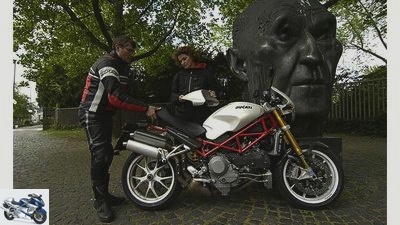
What to do with the pillion seat cover??
Not a tourer, but very sensual: the S4Rs is Ducati’s strongest monster. It carries the fiery, 130 PS producing V2 engine from the 999. And in addition noble, adjustable spring elements from Ohlins, the best Brembo brakes, single-sided swing arm and high-installed silencers.
The stretched seating position, the unfortunate cranked, wide handlebars and the large turning circle are typical of the family. But the easy handling of the Signora, which weighs 203 kilograms, is pleasing.
In stop-and-go, the high manual clutch force and the difficult-to-feel idle speed is annoying. The small one prevents dream ranges
13.5 liter tank, tribute to the voluminous airbox. After all, refueling stops with the beguilingly beautiful, expensive Italian (14,995 euros) quickly result in conversations with sociable people from the Rhineland. But if a passenger wants to get on spontaneously, you don’t know where to put the cover for
the pillion seat. Former Chancellor Adenauer is amazed…
Related articles
-
to travel Ruhr area Ruhr area Layer in the pot The area is in a state of upheaval. Steel mills are being transformed into adventure parks, mines into…
-
Motorcycles in the House of History in Bonn
Blacksmith 14th pictures Blacksmith 1/14 Individually mobile in post-war Germany: with an auxiliary motor on the bike and… Blacksmith 2/14 Now she is…
-
On the way: Hautes Alpes-Piemont – Italian-French border area
Schlueter to travel On the way: Hautes Alpes / Piedmont – Italian-French border area On the way: Hautes Alpes / Piemont (with GPS route) Off-road…
-
On the way from Istanbul to the Ruhr area
shepherd 20th pictures shepherd 1/20 The start in Istanbul: The Suleymaniye Mosque towers over the bay of the Golden Horn. shepherd 2/20 Four wins: Four…
-
Daams to travel Out and about in Germany Out and about in Germany From Frankfurt to Frankfurt Two cities with the same name. Which largely exhausts the…
-
BMW CE 04: With electric power through the metropolitan area
News 2022 New motorcycle items for 2022 BMW 27 pictures BMW 1/27 With the CE 04, BMW brings the successor to the C Evolution. BMW 2/27 The new electric…
-
Jahn to travel Around the Nurburgring Around the Nurburgring Life from the Green Hell The Nurburgring not only attracts people, it shapes them. People…
-
to travel Rhon Rhon With the Indians of Germany When their mountains were declared a biosphere reserve by UNESCO, the Rhon people believed their fate…
-
to travel Hamburg Hamburg Harbour Cruise The million city in the north is not only home to the largest seaport and the most famous entertainment district…
-
to travel Hunsruck Hunsruck Last exit Hunsruck Endless curves, dense forests and the oldest city in Germany ?? the Hunsruck, the low mountain range…